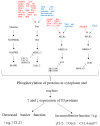Progress in Mycotoxins Affecting Intestinal Mucosal Barrier Function
- PMID: 31174254
- PMCID: PMC6600655
- DOI: 10.3390/ijms20112777
Progress in Mycotoxins Affecting Intestinal Mucosal Barrier Function
Abstract
Mycotoxins, which are widely found in feed ingredients and human food, can exert harmful effects on animals and pose a serious threat to human health. As the first barrier against external pollutants, the intestinal mucosa is protected by a mechanical barrier, chemical barrier, immune barrier, and biological barrier. Firstly, mycotoxins can disrupt the mechanical barrier function of the intestinal mucosa, by destroying the morphology and tissue integrity of the intestinal epithelium. Secondly, mycotoxins can cause changes in the composition of mucin monosaccharides and the expression of intestinal mucin, which in turn affects mucin function. Thirdly, mycotoxins can cause damage to the intestinal mucosal immune barrier function. Finally, the microbiotas of animals closely interact with ingested mycotoxins. Based on existing research, this article reviews the effects of mycotoxins on the intestinal mucosal barrier and its mechanisms.
Keywords: intestinal barrier; intestinal mucosa; mycotoxins.
Conflict of interest statement
This article has not been published elsewhere in whole or in part. All authors have read and approved the content and agreed to submit for consideration for publication in the journal. The authors declared no conflicts of interest. All work complies with the Ethical Policies and has been conducted under internationally accepted ethical standards after relevant ethical review.
Figures

References
-
- Maresca M., Yahi N., Younès-Sakr L., Boyron M., Caporiccio B., Fantini J. Both direct and indirect effects account for the pro-inflammatory activity of enteropathogenic mycotoxins on the human intestinal epithelium: Stimulation of interleukin-8 secretion, potentiation of interleukin-1β effect and increase in the transepithelial passage of commensal bacteria. Toxicol. Appl. Pharmacol. 2008;228:84–92. - PubMed
-
- Biomin . Report on the Detection of Mycotoxins in Raw Materials and Feeds in 2018. Biomin; Inzersdorf-Getzersdorf, Austria: 2019.
Publication types
MeSH terms
Substances
LinkOut - more resources
Full Text Sources
Research Materials

